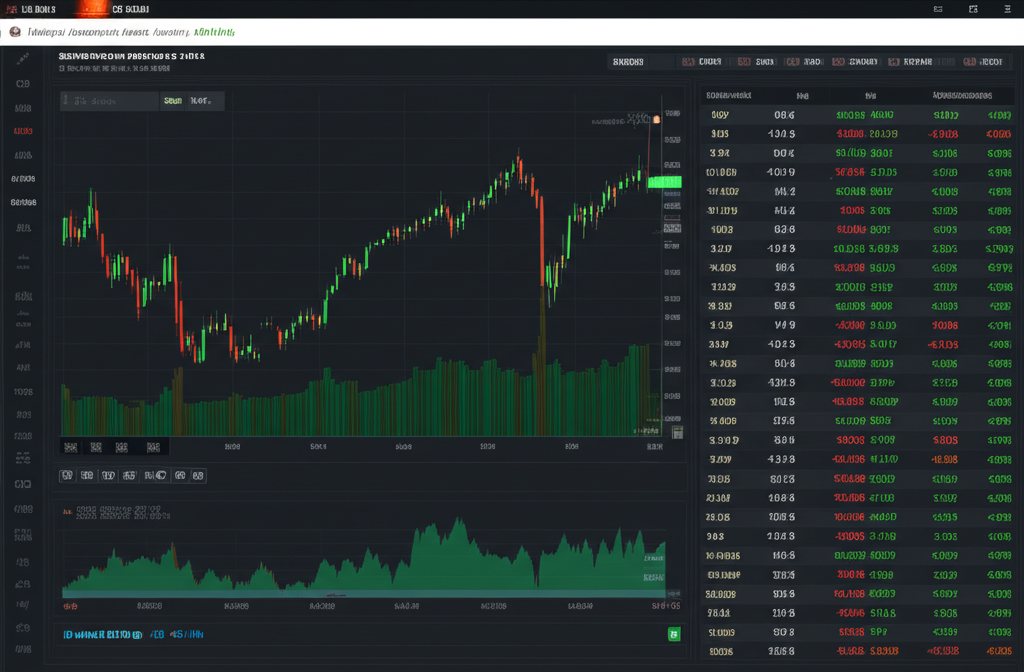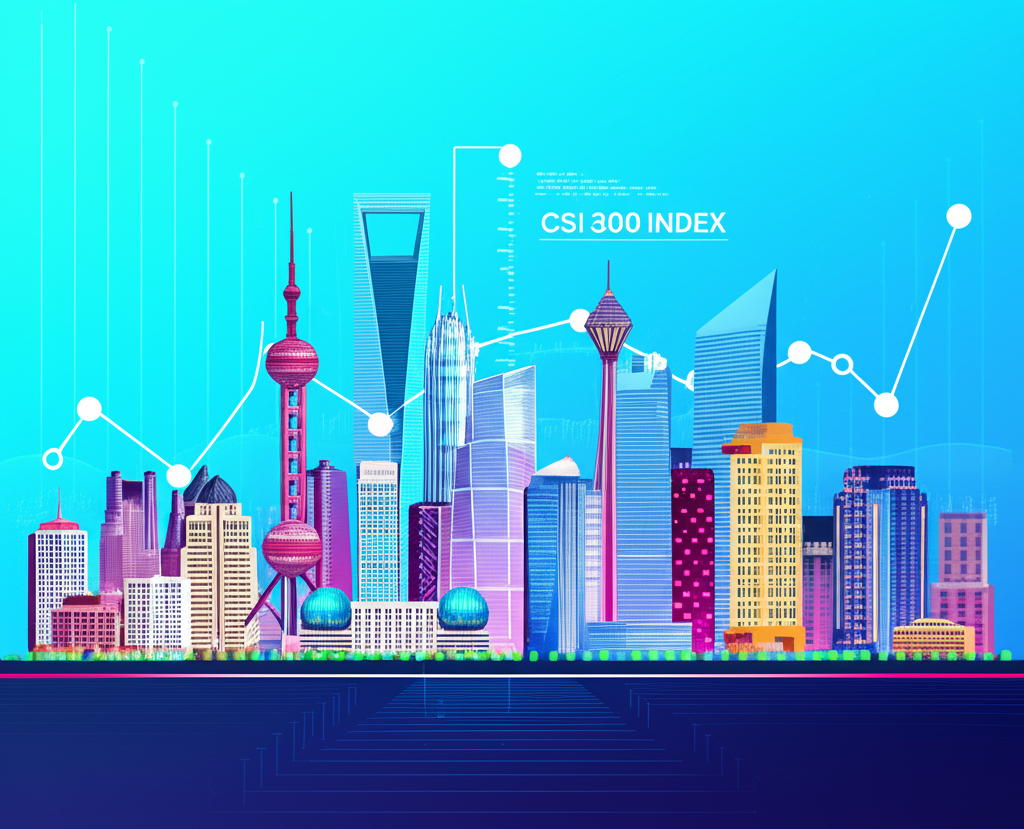Introduction: Navigating the Dynamics of Chinese Stock Markets

China’s stock markets have evolved into one of the most influential financial arenas in the world, combining immense scale with rapid, sometimes unpredictable movements. As the backbone of the world’s second-largest economy, the performance of Chinese equities doesn’t just reflect domestic conditions—it sends ripples across global asset classes, shaping investment flows and policy decisions far beyond its borders. With a growing number of international investors seeking exposure to China’s economic transformation, understanding the inner workings of its stock exchanges has never been more critical. This guide offers a clear, in-depth look at the core indices driving mainland and Hong Kong markets—from real-time performance metrics to the structural nuances that define investor access and market behavior. Whether you’re tracking daily fluctuations or planning long-term allocations, this analysis provides the context needed to navigate one of the most complex yet rewarding financial ecosystems today.
Chinese Stock Markets Live: Real-time Data & Key Indices Overview

To truly grasp where the Chinese market stands at any given moment, access to timely and accurate data is essential. The major indices act as vital signposts, each offering a different lens through which to view the broader economy. From the sweeping reach of the Shanghai Composite to the innovation-driven Shenzhen Component, and the balanced benchmark of the CSI 300, these metrics help investors assess everything from sectoral momentum to macroeconomic confidence. In this section, we break down the current readings of each key index, supported by live tracking features and interactive visualizations designed to highlight trends and turning points. By integrating real-time updates with historical context, investors can move beyond surface-level numbers and begin to interpret the underlying forces shaping market direction.
Shanghai Composite Index (SSEC) Live Updates
The Shanghai Composite Index (SSEC) remains the most recognized gauge of mainland China’s equity landscape. Covering all A-shares and B-shares listed on the Shanghai Stock Exchange, it reflects the performance of a broad cross-section of industries, including financials, energy, and large state-owned enterprises. Real-time SSEC data—including current value, daily point and percentage changes, trading volume, and intraday highs and lows—offers immediate insight into market sentiment. Interactive charts allow users to zoom in on specific timeframes, from minute-by-minute intraday swings to year-to-date trends, enabling both technical traders and long-term strategists to analyze patterns. Given its sensitivity to policy shifts and liquidity conditions, the SSEC often reacts sharply to central bank actions or regulatory announcements, making continuous monitoring crucial for informed decision-making.
Shenzhen Component Index (SZCOMP) Live Tracking
While the Shanghai market leans toward traditional heavyweights, the Shenzhen Component Index (SZCOMP) captures a younger, more dynamic segment of China’s economy. Dominated by private-sector firms, especially in technology, biotech, and new energy, the SZCOMP is frequently seen as a barometer of innovation and entrepreneurial activity. Live tracking of the index reveals how growth-oriented sectors are faring amid evolving consumer trends and government support for strategic industries. The accompanying interactive chart allows for detailed examination across multiple durations—1-day, 5-day, monthly, or longer—helping investors identify momentum shifts and volatility clusters. As Shenzhen continues to emerge as a global tech hub, the index increasingly serves as a proxy for China’s transition toward a knowledge-based and consumption-driven economy.
CSI 300 Index Live Performance

The CSI 300 Index is widely regarded as the gold standard for measuring the health of China’s A-share market. By combining the 300 largest and most liquid stocks from both the Shanghai and Shenzhen exchanges, it provides a comprehensive snapshot of the nation’s corporate elite—from industrial giants and banks to leading tech and consumer brands. Real-time data for the CSI 300 includes up-to-the-minute pricing, daily gains or losses, and trading volume, all presented alongside an interactive chart that supports technical analysis tools like moving averages and volume profiles. Because it represents a diversified cross-section of the economy, the CSI 300 is often used by institutional investors and ETFs as a benchmark for portfolio performance and market exposure. Its movements tend to reflect broader economic confidence, making it a key indicator during periods of policy transition or external stress.
Hang Seng Index (HSI) Live: Hong Kong’s China Market Barometer
Although the Hang Seng Index (HSI) tracks companies listed on the Hong Kong Stock Exchange, its composition makes it a powerful lens into investor sentiment toward Chinese businesses. Many of China’s largest firms—particularly in technology, property, and finance—choose to list in Hong Kong, where they gain access to international capital and operate under a common law framework. As a result, the HSI often reacts more quickly to global risk sentiment than mainland indices, serving as an early warning system for shifts in foreign investor appetite. Real-time HSI data, including live price, daily change, and volume, is displayed with a dynamic chart that enables users to analyze reactions to U.S. interest rate decisions, geopolitical headlines, or earnings surprises. The index’s dual role—as both a local Hong Kong benchmark and a proxy for offshore Chinese equities—makes it indispensable for global market watchers.
Interactive Charts & Historical Performance Analysis

Data becomes meaningful only when it’s visualized effectively. Interactive charts transform raw numbers into actionable intelligence, allowing investors to detect patterns, validate hypotheses, and anticipate potential turning points. Our platform integrates advanced charting tools that support technical indicators such as RSI, MACD, and Bollinger Bands, enabling users to apply sophisticated analysis directly to live and historical data for the SSEC, SZCOMP, CSI 300, and HSI. These tools are especially valuable in the Chinese context, where markets often exhibit strong momentum moves driven by policy interventions or sudden shifts in investor behavior.
Historical analysis further enhances this perspective. Examining the past one, three, or five years reveals how major events—such as the 2015 market correction, the 2020 pandemic rebound, or the 2021 regulatory crackdown on tech—have shaped current valuations and investor psychology. For example, periods of rapid credit expansion typically coincide with surges in retail participation and index volatility, while tightening cycles often trigger consolidation. Understanding these cycles helps investors distinguish between temporary noise and structural shifts. Moreover, seasonal factors—like the pre-holiday rally during Lunar New Year or reduced liquidity during summer months—add another layer of nuance to chart interpretation.
What’s Driving Chinese Stock Markets Today? Latest News & Contextual Analysis
Market movements rarely occur in isolation. Behind every uptick or downturn lies a web of economic data, policy decisions, and global developments that shape investor expectations. Staying informed about these drivers is not optional—it’s fundamental to successful investing in China’s fast-moving environment.
Economic Indicators & Monetary Policy Impact
China’s economic pulse is monitored through a suite of key indicators. GDP growth figures offer a high-level view of overall expansion, while CPI and PPI data reveal inflationary pressures across consumer and industrial sectors. The manufacturing PMI, closely watched by global investors, signals whether factory activity is expanding or contracting. Similarly, retail sales data provides insight into domestic demand, a growing pillar of economic growth amid efforts to reduce reliance on exports.
Monetary policy, set by the People’s Bank of China (PBoC), plays a pivotal role in steering market sentiment. Adjustments to benchmark lending rates, reserve requirement ratios (RRR), and open market operations directly affect liquidity and borrowing costs. For instance, a recent Bloomberg report highlighted mixed signals in China’s April economic data, showing resilience in industrial output but weakness in property investment and consumer confidence. Such divergences can lead to sector-specific reactions, with infrastructure-linked stocks gaining on stimulus hopes while real estate developers face continued pressure.
Geopolitical Factors & Global Trade Dynamics
No discussion of Chinese markets is complete without addressing the impact of geopolitical tensions. The U.S.-China relationship, in particular, influences everything from technology access to capital flows. Tariff disputes, export controls on semiconductors, and scrutiny of Chinese companies listed abroad can trigger sharp market reactions. At the same time, global supply chain realignments and commodity price swings—driven by events like Middle East conflicts or climate disruptions—affect sectors such as shipping, raw materials, and manufacturing.
Investors must also consider how China’s role in multilateral trade agreements, such as the Regional Comprehensive Economic Partnership (RCEP), shapes long-term growth prospects. Positive developments in diplomatic relations or trade negotiations can boost investor confidence, while escalations risk triggering capital outflows and risk-off behavior across equity markets.
Domestic Policy Shifts & Regulatory Environment
China’s state-led economic model means that government policy often acts as the primary catalyst for market moves. Strategic initiatives like “Made in China 2025” or the dual circulation strategy aim to boost self-reliance in critical technologies and strengthen domestic demand. These top-down priorities create tailwinds for targeted sectors—such as electric vehicles, renewable energy, and AI—while redirecting capital away from others.
Regulatory interventions can be equally powerful. The 2021 crackdown on private education and tech platforms sent shockwaves through the market, underscoring the risks of sudden policy reversals. Conversely, recent signals of regulatory easing in the internet sector have helped restore some investor confidence. The unpredictability of such shifts demands that investors remain agile, closely monitoring official media outlets like Xinhua and policy statements from the State Council.
Sectoral Performance & Major Market Movers
Beyond broad indices, dissecting sector-level performance reveals where the real action is happening. Daily updates highlight leaders and laggards—whether it’s a surge in新能源 (new energy) stocks due to policy support, or declines in property developers amid debt concerns. Individual companies often drive index movements: a blockbuster earnings report from a major EV maker, a breakthrough in battery technology, or a large-scale buyback program can lift entire sectors.
Tracking these movers helps investors differentiate between broad market trends and isolated events. For example, a rally in chip stocks may reflect both strong earnings and renewed government support for semiconductor self-sufficiency, whereas a drop in consumer stocks might signal weakening household spending. By combining macro insights with micro-level analysis, investors can better position themselves ahead of broader market shifts.
Understanding the Unique Structure of China’s Stock Markets
China’s capital markets operate under a distinctive framework that blends elements of market capitalism with state oversight. For foreign investors, navigating this landscape requires more than just financial acumen—it demands an understanding of market segmentation, regulatory oversight, and access mechanisms that differ sharply from Western norms.
A-shares vs. H-shares vs. B-shares: A Comprehensive Distinction
The classification of Chinese shares reflects the country’s phased approach to financial liberalization.
- A-shares: Issued by mainland companies and traded on the Shanghai or Shenzhen exchanges in RMB. Historically restricted to domestic investors, they are now accessible to foreigners through programs like Stock Connect. Due to limited access and higher retail participation, A-shares often trade at a premium compared to their H-share counterparts.
- H-shares: Represent shares of mainland companies listed in Hong Kong and traded in HKD. They offer greater transparency and regulatory clarity under Hong Kong’s legal system and are widely held by international institutional investors. Price discrepancies between A-shares and H-shares—known as the A-H premium—remain a point of interest for arbitrageurs and value investors.
- B-shares: Once intended for foreign investors, these RMB-denominated shares traded in foreign currencies (USD in Shanghai, HKD in Shenzhen) have largely been sidelined since the introduction of more efficient access routes. Trading volumes are low, and their relevance has faded over time.
These distinctions affect not only pricing and liquidity but also investor sentiment and risk assessment.
Regulatory Framework & Foreign Investor Access Mechanisms
The China Securities Regulatory Commission (CSRC) oversees all securities activities in mainland China, setting rules for listings, disclosures, and market conduct. While the framework has improved in transparency, enforcement can be inconsistent, and political considerations sometimes override market logic.
For foreign investors, several pathways exist to enter the A-share market:
- QFII/RQFII: The Qualified Foreign Institutional Investor and Renminbi QFII programs allow approved institutions to invest directly in mainland securities within allocated quotas. Though once the main channel, they’ve been largely superseded by more flexible options.
- Stock Connect: Launched in 2014 (Shanghai) and 2016 (Shenzhen), these cross-border trading links enable international investors to buy eligible A-shares through Hong Kong brokers without needing a mainland license. The program has dramatically increased foreign ownership and market integration. More information is available on the Hong Kong Exchanges and Clearing (HKEX) website.
These mechanisms have opened the door to global capital, though full liberalization remains a work in progress.
Trading Hours, Market Holidays & Suspension Rules
The Shanghai and Shenzhen exchanges operate on Beijing Time (GMT+8), with trading split into two sessions:
- Morning: 09:30 – 11:30
- Lunch break: 11:30 – 13:00
- Afternoon: 13:00 – 15:00
There is no daylight saving adjustment. Trading halts occur on major public holidays, including Chinese New Year, National Day (October 1), and Qingming Festival. The official holiday calendar is published annually by the exchanges and must be monitored closely, especially during extended break periods that can affect liquidity.
Additionally, individual stocks may be suspended for reasons such as pending announcements, abnormal price movements, or regulatory investigations. Circuit breakers at the index level were introduced and later modified after market turbulence in 2016, reflecting ongoing efforts to balance stability with market efficiency.
Investing in Chinese Stock Markets: Opportunities, Risks & Outlook
For global investors, China presents a compelling but complex proposition. The potential rewards are substantial, yet the risks require careful calibration and ongoing vigilance.
Unlocking Opportunities: Growth Sectors & Market Potential
Several structural trends underpin long-term investment potential:
- Domestic Consumption: With over 400 million middle-class consumers, China’s internal market is a powerful engine for growth in retail, healthcare, education, and digital services.
- Technological Innovation: Heavy investment in AI, 5G, quantum computing, and fintech is positioning China as a leader in next-generation technologies, supported by a thriving startup ecosystem.
- Green Transition: The commitment to carbon neutrality by 2060 is fueling massive investments in solar, wind, hydrogen, and electric mobility, creating opportunities across the energy value chain.
- Urbanization & Infrastructure: Despite high development levels, continued urban expansion and smart city projects sustain demand for construction, materials, and industrial equipment.
Sectors aligned with national strategy often benefit from favorable policies, subsidies, and state-backed financing, amplifying their growth trajectories.
Navigating Key Risks for Foreign Investors
However, these opportunities come with notable challenges:
- Policy Risk: Sudden regulatory changes—such as those affecting tutoring, gaming, or data security—can erase market value overnight.
- Geopolitical Exposure: Escalating tensions with the U.S. and its allies increase the risk of sanctions, delistings, and technology bans.
- Currency Volatility: The RMB is managed rather than fully floating, and its value can shift based on capital controls and trade balances, affecting returns for foreign holders.
- Governance Standards: While improving, disclosure practices and shareholder rights in some firms still lag behind international norms, raising due diligence requirements.
- Market Volatility: High retail participation—estimated at over 60% of daily turnover—can amplify price swings and speculative bubbles.
The International Monetary Fund regularly assesses these risks in its country reports, offering a macro-level view of financial stability and reform progress.
Expert Outlook & Future Trends
Looking ahead, the trajectory of Chinese markets will hinge on how well the country balances growth, stability, and openness. Financial reforms are expected to continue, including deeper integration with global indices, enhanced disclosure rules, and greater protection for minority shareholders. However, geopolitical friction and domestic economic headwinds—such as slowing productivity and a demographic downturn—pose significant constraints.
Experts remain divided: some see China evolving into a more transparent, market-driven system over time, while others caution that state influence will remain dominant. What’s clear is that investors must adopt a flexible, multi-scenario approach, combining real-time monitoring with deep structural analysis to adapt to an ever-changing landscape.
Conclusion: Staying Informed in a Dynamic Global Market
The Chinese stock market is no longer a niche frontier—it’s a central pillar of the global financial system. Its influence extends far beyond Asia, affecting everything from commodity prices to tech innovation worldwide. To engage effectively, investors need more than just data; they need context. Real-time indices, interactive charts, and live news are essential tools, but they must be interpreted through an understanding of China’s unique market structure, regulatory environment, and policy priorities.
Whether you’re evaluating short-term trades or building long-term portfolios, success depends on staying alert to shifting fundamentals and sentiment. By combining up-to-the-minute insights with a grounded perspective on risks and opportunities, market participants can navigate China’s complexities with greater confidence and clarity.
What are the primary stock market indices in mainland China and Hong Kong, and what do they represent?
The primary stock market indices in mainland China are the Shanghai Composite Index (SSEC), which tracks all A-shares and B-shares on the Shanghai Stock Exchange, and the Shenzhen Component Index (SZCOMP), focusing on innovative and tech companies on the Shenzhen Stock Exchange. The CSI 300 Index is a benchmark for 300 large, liquid A-shares from both exchanges. In Hong Kong, the Hang Seng Index (HSI) is the benchmark, reflecting sentiment towards major companies, including many mainland Chinese firms listed there.
How can I access reliable live charts and real-time data for Chinese stock markets today?
Reliable live charts and real-time data for Chinese stock markets can be accessed through various financial platforms and news websites. Many reputable financial data providers offer dynamic, interactive charts for the SSEC, SZCOMP, CSI 300, and HSI, along with current values, daily changes, and trading volumes. This article also provides descriptions of where such data would be integrated for immediate access.
What are the typical trading hours for the Shanghai and Shenzhen Stock Exchanges in Beijing Time, and are there any breaks?
The Shanghai and Shenzhen Stock Exchanges typically operate from 09:30 to 15:00 Beijing Time (GMT+8), with a lunch break. The morning session runs from 09:30 to 11:30, followed by a break from 11:30 to 13:00, and the afternoon session from 13:00 to 15:00. These exchanges do not observe daylight saving time.
Which key economic indicators and government policies most significantly influence Chinese stock market performance?
Key economic indicators include GDP growth, inflation rates (CPI, PPI), manufacturing PMIs, and retail sales. Government policies, especially those from the People’s Bank of China (PBoC) regarding monetary policy (interest rates, reserve requirements) and domestic regulatory changes (e.g., in technology, real estate, or specific industries), exert significant influence. Geopolitical developments and global trade relations also play a crucial role.
What is the fundamental difference between A-shares, B-shares, and H-shares, and who is eligible to trade each?
- A-shares: Shares of mainland Chinese companies listed on Shanghai/Shenzhen exchanges, denominated in RMB. Primarily for domestic investors, but accessible to foreign investors via Stock Connect or QFII/RQFII programs.
- B-shares: Shares of mainland Chinese companies listed on Shanghai/Shenzhen exchanges, denominated in foreign currencies (USD/HKD). Historically for foreign investors, but now less significant.
- H-shares: Shares of mainland Chinese companies listed on the Hong Kong Stock Exchange, denominated in HKD. Fully accessible to international investors.
Is the Chinese stock market open today, and where can I find the official calendar for market holidays?
To confirm if the Chinese stock market is open today, you should consult an up-to-date financial news portal or the official websites of the Shanghai Stock Exchange or Shenzhen Stock Exchange. These official sources publish the annual calendar of market holidays, which includes public holidays like Chinese New Year, National Day, and other significant non-trading days.
How do geopolitical events and global trade relations impact investor sentiment in China’s stock market?
Geopolitical events, particularly US-China relations, and global trade dynamics significantly influence investor sentiment. Tensions, trade disputes, or sanctions can lead to increased uncertainty, capital outflows, and negative impact on sectors reliant on international trade or technology. Conversely, positive developments can boost confidence and drive market rallies, affecting both mainland and Hong Kong-listed Chinese companies.
What are the primary mechanisms available for international investors to gain direct exposure to mainland Chinese A-shares?
International investors can gain direct exposure to mainland Chinese A-shares primarily through the Stock Connect programs (Shanghai-Hong Kong Stock Connect and Shenzhen-Hong Kong Stock Connect). Additionally, institutional investors may access A-shares via the Qualified Foreign Institutional Investor (QFII) and Renminbi Qualified Foreign Institutional Investor (RQFII) schemes, which grant specific quotas for direct investment.
What are the major opportunities and inherent risks that foreign investors should consider when looking at Chinese stocks?
Opportunities: Strong domestic consumption growth, rapid technological innovation, significant investment in green energy, and ongoing infrastructure development. Risks: Policy uncertainty and sudden regulatory shifts, geopolitical tensions, currency fluctuations, corporate governance concerns, and high market volatility.
Where can I find comprehensive, up-to-the-minute news updates and expert analysis specifically focused on the Chinese stock market?
For comprehensive, up-to-the-minute news and expert analysis on the Chinese stock market, reputable financial news outlets such as Bloomberg, Reuters, Financial Times, and The Wall Street Journal are excellent resources. Specialized financial data platforms and local Chinese financial news services (often available in English translations) also provide in-depth coverage and analysis.

留言